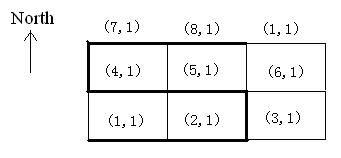HDU 2490 Parade(DPの单调队列)(2008 Asia Regional Beijing)
Description
When seeing his Citizens, Panagola always waves his hands. He may get tired and need a break. So please never make Panagola travel in a same west-east road for more than k minutes. If it takes p minutes to pass a love-hate zone, we say the length of that love-hate zone is p. Of course you know every love-hate zone’s length.
The figure below illustrates the case in sample input. In this figure, a best route is marked by thicker lines.
Input
The first line contains three integers: n, m and k.(0<n<=100,0<m<=10000, 0<=k<=3000000)
The next n+1 lines stands for n + 1 west-east roads in north to south order. Each line contains m integers showing the welcome values of the road’s m love-hate zones, in west to east order.
The last n+1 lines also stands for n + 1 west-east roads in north to south order. Each line contains m integers showing the lengths (in minutes) of the road's m love-hate zones, in west to east order.
Output
题目大意:有一个n*m的矩阵,只能沿着边走,只能往左、往右或往上走,在同一行只能沿一个方向走(走了左边就不能返回走右边了)。打横的边都有一个权值(可能为负数)和一个长度,每行走过的长度不能超过k,打竖的边没有权值和长度。先要从最下面的任意一个点开始,走到最上面的任意一个点,问最大权值和为多少(答案不超过$2^{31}-1$,虽然题目不是这么说的)。
思路:一看就是动态规划,每一行只和上一行的状态有关。因为习惯从小到大循环我们从上往下走,反正都一样。设dp[i][j]为走到第 i 行第 j 个点的最大权值(已往左往右走完),那么dp[i][j] = max(dp[i-1][x] + sum(welcome[i][y])),distance(x, y) ≤ k,y in [x, i]。其中distance和sum(welcome[i][y])可以预处理出来(如sum[i]代表1~i的和,distance(i, j) = sum[j] - sum[i],i ≤ j),平均到处理每个dp[i][j]身上时间复杂度为O(1)。但是这样计算dp数组,时间复杂度高达$O(nm^2)$。
现假设我们从左到右走,那么dp[i][j] = max(dp[i - 1][x] - sum_welcome[x] + sum_welcome[y]) = dp[i][j] = max(dp[i - 1][x] - sum_welcome[x]) + sum_welcome[y],那么对每一个j,所用的dp[i - 1][x] - sum_welcome[x]都是一样的,这里很容易能想到单调队列优化(如果你知道单调队列的话)。每次把队列末尾小于dp[i - 1][j] - sum_welcome[j]弹出,把队头distance(i, x) > k的弹出,队头就是最佳的dp[i - 1][x] - sum_welcome[x]。优化完时间复杂度为$O(nm)$,已经是读入数据的复杂度了。(这里不介绍单调队列)
PS:可恶这题居然不让人在线非要我把整个矩阵一起读进来……
代码(1078MS,可恶啊C++又比G++快一倍):
#include <cstdio>
#include <cstring>
#include <iostream>
#include <algorithm>
using namespace std; const int MAXN = ;
const int MAXM = ; int wel[MAXN][MAXM], len[MAXN][MAXM];
int sum_w[MAXM], sum_l[MAXM];
int a[MAXM], b[MAXM], head, tail;
int dp[][MAXM];
int n, m, k, cur; inline void insert(int x, int y) {
while(head != tail && a[tail - ] < x) --tail;
a[tail] = x; b[tail] = y; ++tail;
} void solve() {
memset(dp, , sizeof(dp));
cur = ;
for(int i = ; i < n; ++i) {
cur ^= ;
memset(dp[cur], , sizeof(dp[cur])); sum_w[] = sum_l[] = ;
for(int j = ; j <= m; ++j) sum_w[j] = sum_w[j - ] + wel[i][j];
for(int j = ; j <= m; ++j) sum_l[j] = sum_l[j - ] + len[i][j];
head = tail = ;
for(int j = ; j <= m; ++j) {
insert(dp[cur ^ ][j] - sum_w[j], sum_l[j]);
while(k < sum_l[j] - b[head]) ++head;
dp[cur][j] = max(dp[cur][j], a[head] + sum_w[j]);
} sum_w[m] = sum_l[m] = ;
for(int j = m; j > ; --j) sum_w[j - ] = sum_w[j] + wel[i][j];
for(int j = m; j > ; --j) sum_l[j - ] = sum_l[j] + len[i][j];
head = tail = ;
for(int j = m; j >= ; --j) {
insert(dp[cur ^ ][j] - sum_w[j], sum_l[j]);
while(k < sum_l[j] - b[head]) ++head;
dp[cur][j] = max(dp[cur][j], a[head] + sum_w[j]);
}
}
} int main() {
while(scanf("%d%d%d", &n, &m, &k) != EOF) {
if(n == && m == && k == ) break;
++n;
for(int i = ; i < n; ++i)
for(int j = ; j <= m; ++j) scanf("%d", &wel[i][j]);
for(int i = ; i < n; ++i)
for(int j = ; j <= m; ++j) scanf("%d", &len[i][j]);
solve();
int ans = ;
for(int i = ; i <= m; ++i) ans = max(ans, dp[cur][i]);
printf("%d\n", ans);
}
}
HDU 2490 Parade(DPの单调队列)(2008 Asia Regional Beijing)的更多相关文章
- HDU 3401 Trade dp+单调队列优化
题目链接: http://acm.hdu.edu.cn/showproblem.php?pid=3401 Trade Time Limit: 2000/1000 MS (Java/Others)Mem ...
- HDU - 3415(DP + 单调队列)
链接:HDU - 3415 题意:给出一个包含 n 个数的环,求满足长度大于 0 小于等于 k 的最大区间和. 题解:将数组加倍,形成环.求一个前缀和sum.枚举每一个sum[i],以 i 结尾的最大 ...
- HDU 5945 题解(DP)(单调队列)
题面: Fxx and game Time Limit: 3000/1500 MS (Java/Others) Memory Limit: 131072/65536 K (Java/Others) T ...
- hdu 4123 树形DP+单调队列
http://acm.hust.edu.cn/vjudge/problem/25790 这题基本同poj 3162 要注意mx,mx2,vx,vx2每次都要初始化 #include <iostr ...
- HDU 4749 Parade Show 2013 ACM/ICPC Asia Regional Nanjing Online
题目链接:http://acm.hdu.edu.cn/showproblem.php?pid=4749 题目大意:给一个原序列N,再给出一个序列M,问从N中一共可以找出多少个长度为m的序列,序列中的数 ...
- HDU 2494/POJ 3930 Elevator(模拟)(2008 Asia Regional Beijing)
Description Too worrying about the house price bubble, poor Mike sold his house and rent an apartmen ...
- HDU 2492 Ping pong(数学+树状数组)(2008 Asia Regional Beijing)
Description N(3<=N<=20000) ping pong players live along a west-east street(consider the street ...
- HDU 2491 Priest John's Busiest Day(贪心)(2008 Asia Regional Beijing)
Description John is the only priest in his town. October 26th is the John's busiest day in a year be ...
- HDU 2489 Minimal Ratio Tree(暴力+最小生成树)(2008 Asia Regional Beijing)
Description For a tree, which nodes and edges are all weighted, the ratio of it is calculated accord ...
随机推荐
- 在mac下运行 npm run eject 出现报错问题解决方法
当使用create-react-app创建项目后,接着运行npm run eject时,如果出现下面的错误 可能是脚手架添加了.gitignore这个文件,但是没有本地仓库,可以使用以下代码解决这个问 ...
- Linux Centos6.5 升级默认Python2.6.6到Python2.7.13
以下例子基于python 2.7.9,其他版本同理.大致的命令都是差不多的,安装完成之后,输入Python --vertion ,看到系统默认的版本已经替换为2.7版本了 1.下载python wge ...
- 基于JQ的简版选项卡记录
<!DOCTYPE html><html lang="en"><head> <meta charset="UTF-8" ...
- 线上服务内存OOM问题定位三板斧
相信大家都有感触,线上服务内存OOM的问题,是最难定位的问题,不过归根结底,最常见的原因: 本身资源不够 申请的太多 资源耗尽 58到家架构部,运维部,58速运技术部联合进行了一次线上服务内存OOM问 ...
- 大数据学习--day11(抽象类、接口、equals、compareTo)
抽象类.接口.equals.compareTo 什么是抽象方法 ? 区分于正常的方法 1.使用了 abstract 修饰符 该修饰符修饰方法 则该方法就是抽象方 ...
- LinkedList的源码分析(基于jdk1.8)
1.初始化 public LinkedList() { } 并未开辟任何类似于数组一样的存储空间,那么链表是如何存储元素的呢? 2.Node类型 存储到链表中的元素会被封装为一个Node类型的结点.并 ...
- java对象转map
/** * java对象转map * @param obj * @return * @throws IllegalAccessException * @throws IllegalArgumentEx ...
- 20145209刘一阳《网络对抗》Exp6信息搜集与漏洞扫描
20145209刘一阳<网络对抗>Exp6信息搜集与漏洞扫描 实践内容 信息搜集和漏洞扫描 信息搜集 whois查询 用whois查询博客园网站的域名注册信息可以得到注册人的名字.城市等信 ...
- 成都优步uber司机第五组奖励政策
7月14日,成都优步uber团队发布了第五组用户分组.在传言要推出第四组的时候,心想事不过三吧,意外,现在第五组都出来了.一起看看成都优步司机第五组的详细内容!滴滴快车单单2.5倍,注册地址:http ...
- CakePHP 查询总结
返回 $this->Post->buildQuery(); 返回: Array ( [conditions] => [fields] => [joins] => Arra ...

